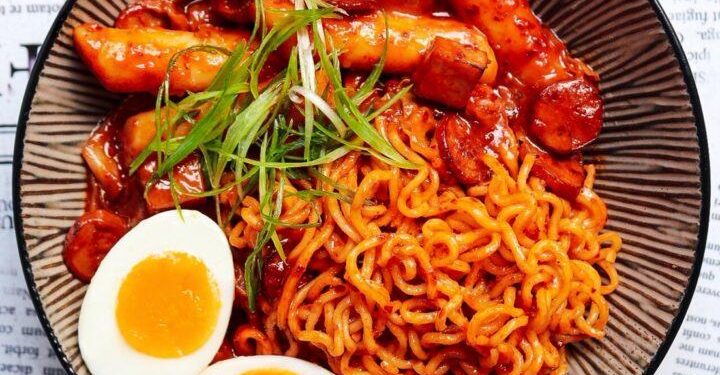A popular South Korean noodle brand has sparked controversy in Denmark after being temporarily banned for its extreme spiciness. The instant noodle, renowned for its fiery flavor profile, was deemed too intense for Danish consumers, leading regulators to pull it from shelves. This unusual move has ignited a wider conversation about cultural differences in spice tolerance and food regulation policies across countries. In this article, we explore the background of the spicy noodle brand, the reasons behind the ban, and its impact on both markets.
South Korean Noodle Brand Faces Danish Ban Over Intense Heat Levels
In a surprising move that made headlines across Europe, Denmark imposed a temporary ban on a popular South Korean instant noodle brand, citing safety concerns over its extreme spiciness. The authorities deemed the heat level of the noodles to be dangerously high, warning that it could pose health risks, especially to children and individuals with sensitive digestive systems. The ban became a focal point for discussions on food safety regulations and cultural taste differences, particularly regarding spicy cuisine.
Experts analyzing the product highlighted its Scoville Heat Units (SHU) rating, which far exceeded the levels found in common spicy snacks and meals available in Denmark. The company behind the noodles argued that their product was designed for consumers who appreciate intense heat and bold flavors, mainly targeting the adventurous food enthusiasts market. The controversy sparked debates, both online and offline, about balancing consumer freedom and public health safeguards. Below is a breakdown of the heat comparisons of some popular spicy foods, including the banned noodles:
| Product | Scoville Heat Units (SHU) | Spice Level |
|---|---|---|
| South Korean Instant Noodles | 8,500 | Extreme |
| Jalape√Īo Pepper | 3,500 | Medium |
| Tabasco Sauce | 2,500 | Mild |
| Ghost Pepper | 1,000,000 | Insane |
The Rise of Spicy Korean Cuisine and Its Global Market Challenges
South Korea’s reputation for bold, fiery flavors has skyrocketed in recent years, propelling its spicy noodle dishes into the international spotlight. The intense heat and complex spice blends, often incorporating ingredients like gochugaru (Korean red chili flakes) and fermented pastes, have captivated adventurous eaters worldwide. However, this culinary boldness has not been without friction. One notorious South Korean noodle brand faced outright rejection in European markets for exceeding local standards of spiciness-most notably in Denmark, where officials temporarily banned the product for being “too spicy” and posing potential health concerns for consumers unfamiliar with such heat levels.
Challenges like these illustrate the delicate balance Korean food exporters must strike between authenticity and regulatory compliance. Navigating diverse taste preferences and safety regulations requires strategic adjustments, including:
- Modifying spice levels without diluting cultural identity
- Transparent labeling to inform consumers of heat intensity
- Collaborating with local food safety authorities to meet import standards
While some purists may argue this dilutes genuine flavor, such adaptions are crucial for scaling global presence. The spicy Korean cuisine market now stands at a crossroads: embracing innovation to conquer foreign taste buds while preserving the fiery essence that defines it.
| Region | Max Allowed Spice Level (Scoville Heat Units) | Common Adaptation |
|---|---|---|
| Denmark | 5,000 SHU | Reduced chili extract |
| USA | 15,000 SHU | Clear heat rating on packaging |
| Japan | 8,000 SHU | Substitute with milder pepper varieties |
Expert Tips for Enjoying Extreme Heat Noodles Without Overwhelming Your Palate
When diving into the fiery depths of extreme heat noodles, pacing is essential to truly savor the complex layers of spice without numbing your taste buds. Start by mixing the seasoning gradually rather than dumping the entire packet at once. This allows your palate to adjust and helps you appreciate the harmony between the subtle sweetness, tangy undertones, and smoky elements often hidden beneath the initial heat blast. Cooling sides, such as a crisp cucumber salad or a dollop of plain yogurt, act as a gentle palate cleanser, offering relief without diluting the bold flavor profile.
Keep in mind these practical tips for an optimized tasting experience:
- Alternate bites with neutral-flavored rice or steamed vegetables to mitigate burn intensity
- Use a small sip of milk or soy milk to calm the heat, as water can often spread the spiciness
- Allow the noodles to cool slightly before eating to prevent overwhelming your senses
- Take breaks between bites to avoid rapid palate fatigue and to prolong enjoyment
| Tip | Why It Works |
|---|---|
| Gradual seasoning | Controls spice intensity |
| Cooling sides | Balances flavors |
| Milk sips | Neutralizes capsaicin |
| Pausing between bites | Prevents palate burnout |
In Conclusion
The story of this South Korean noodle brand underscores the complex dynamics of global food regulation and cultural palate differences. What was once deemed excessively spicy for Danish consumers has since found its place on shelves, reflecting changing tastes and a growing appreciation for international flavors. As the brand continues to expand its reach, it serves as a reminder of how culinary boundaries are constantly being tested and redefined in an increasingly interconnected world.
















